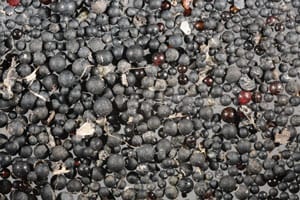
Tiny microscopic animals called zooplankton are ingesting plastic particles at an alarming rate, according to a new study by Dr. Peter Ross, head of the Ocean Pollution Research Program at Vancouver Aquarium Marine Science Centre. That could spell trouble for the entire aquatic food web.
In a scientific paper released June 12 in the international journal Archives of Environmental Contamination and Toxicology, Dr. Ross and his co-authors, Jean-Pierre Desforges and Moira Galbraith, report on microplastic particles found in two key species of zooplankton found in the Northeast Pacific Ocean: copepods and euphausiids. The findings show plastic in one out of every 34 copepods, and in one in every 17 euphausiids. It’s the first indisputable evidence that species at the bottom of the food web are mistaking plastic for food, which raises troubling questions about species that rely on these invertebrates for food, such as B.C. salmon.
“Zooplankton represent a critical energy source in the world’s oceans and a vital food for many fish and marine mammal species. Most salmon species feed heavily on copepods and euphausiids during their juvenile and adult life stages. The potential transfer of microplastics in the food web, from zooplankton to Pacific salmon that ingest them, would be a great concern given the importance of salmon in our regional ecosystems,” said Dr. Ross. “These particles could pose a serious risk of physical harm to the marine animals that consume them, potentially blocking their gut or leaching chemicals into their bodies.”
Microplastics refer to barely visible litter in the form of small fragments, fibres and granules. They may be deliberately manufactured, as is the case with microbeads in exfoliants or toothpastes, or may result from the breakdown of larger pieces of plastic or textiles. The microplastics found in the zooplankton in this study consisted of small fragments and fibers, but not the deliberately designed microbeads that may sink to the sediments in the ocean.
The study focused on four major areas in coastal B.C.: Strait of Georgia, west coast Vancouver Island, northern Vancouver Island/Haida Gwaii and offshore Pacific. The highest concentrations observed were in the Strait of Georgia for both species of zooplankton. “We believe microplastic ingestion by zooplankton to be a bigger problem near urban areas,” Dr. Ross noted.
The authors estimate using findings in zooplankton that juvenile salmon in the Strait of Georgia may be ingesting two to seven microplastic particles per day, and returning adult salmon are ingesting up to 91 particles per day. The Strait of Georgia is a crucial feeding ground for salmon, notably tiny smolts as they migrate out to the ocean.
Dr. Ross’ team also notes the data can be used to estimate what larger marine mammals might ingest based on their feeding rates on zooplankton. Using this method, they estimate a humpback, which is a baleen whale, could ingest more than 300,000 microplastic particles per day.
Read more: Microplastics entering ocean food web through zooplankton, researchers find
The Latest on: Microplastics
[google_news title=”” keyword=”Microplastics” num_posts=”10″ blurb_length=”0″ show_thumb=”left”]
via Google News
The Latest on: Microplastics
- Researchers uncover new oceanic locations where microplastics are accumulating: 'Global initiatives are necessary to conserve these rich ecosystems'on April 27, 2024 at 3:15 am
If coral reefs die or dwindle in health, whole ecosystems could be affected. Researchers uncover new oceanic locations where microplastics are accumulating: 'Global initiatives are necessary to ...
- Toxic chemicals from microplastics can be absorbed by the skin, study findson April 26, 2024 at 8:20 am
A new study used 3D human skin-equivalent models to examine how flame retardant additives in microplastics are absorbed by the skin. The findings show that several flame-retardant additives passed ...
- Breaking the Skin Barrier: Scientists Discover New Health Risks of Microplasticson April 26, 2024 at 2:13 am
New research indicates that toxic chemicals added to plastic materials for flame resistance can enter the body through the skin by contact with microplastics. The study offers the first experimental ...
- 5 Ways To Reduce Your Microplastics Exposure In The ‘Plasticene’ Eraon April 25, 2024 at 4:30 am
Emerging research shows microplastics—which are everywhere—are linked to health problems. Here are five ways to reduce your microplastics exposure.
- Earth Week underway as UN committee debates plastics and microplastics. Here's why.on April 23, 2024 at 10:29 am
Plastic has become ubiquitous in our environment. It's now considered "a crisis of global proportion," according to as United Nations' committee.
- Experts tell lawmakers about harmful effects of microplasticson April 23, 2024 at 3:37 am
One expert cited a link between the creation of plastic and dramatically declining fertility rates and sperm counts. The post Experts tell lawmakers about harmful effects of microplastics appeared ...
- Researchers working to keep microplastics from laundry out of water supplyon April 22, 2024 at 4:38 pm
Doing the laundry can also lead to microplastics polluting the water supply and oceans, as the particles are shed from certain kinds of fabrics. A group of researchers are working to create a device ...
- Microplastics found in food and water may spread from the gut to the brainon April 19, 2024 at 9:33 am
A new study conducted in mice found that microplastics can spread from the gut to other organs in the body, such as the brain, liver, and kidneys.
- Microplastics Found in Brain After Only 4 Weeks of Exposureon April 18, 2024 at 10:22 am
A new study found microplastics in the liver, kidneys, and brains of mice after only four weeks of drinking microplastic-tainted water. Microplastics are found in everything from water bottles to food ...
- Study finds evidence of microplastics in brains and other organson April 17, 2024 at 6:00 pm
Two recently-published studies investigated how microplastics can find their way inside the organs of both humans and mice and what the potential impact can be.
via Bing News










